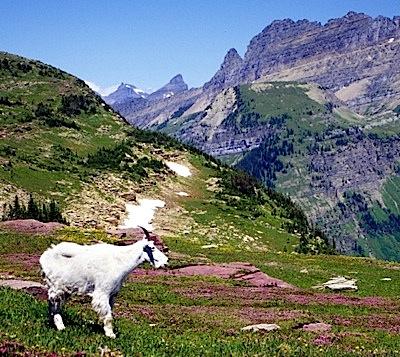 Are mountain goats in Glacier National Park behaving as they should? A study is examining that question/Kurt Repanshek.
Are mountain goats in Glacier National Park behaving as they should? A study is examining that question/Kurt Repanshek.Stylish collars and perhaps a splash of paint will mark some mountain goats this summer at Glacier National Park in Montana, where an ongoing study of the animals is moving into its second year.
Style aside, the first year of research already is producing results, as wildlife biologists say the park has two types of goats -- those that are "habituated," or used to being around human visitors, and "wild" goats, those that act as wild animals should and don't often hang out in areas where there are humans.
Better understanding mountain goat behavior is key to both protecting park visitors and protecting the goats themselves. So habituated to human visitors are some mountain goats at Glacier that they can seem as docile and innocent as sheep. Of course, that's not the case at all. Mountain goats, just like grizzlies, bison, and wolves, are wild animals that can behave unpredicatably around humans in national parks. That point was driven home just four years ago when a hiker was fatally gored by a mountain goat in Olympic National Park.
In the wake of that incident, Olympic officials implemented a mountain goat management plan, part of which urged hikers not to urinate on trails, as the salty deposits in effect become "long linear salt licks" that lure the goats. But at the time Glacier officials said they had no plans to alter their management plans or visitor regulations when it came to wildlife.
Now, though, Glacier officials are embarking on a study with the University of Montana to better understand exactly how habituated mountain goats have become to people, trails, and roads in the Logan Pass area. The project, which got under way last year, is being conducted by the National Park Service in partnership with the University of Montana and Montana Fish, Wildlife and Parks. The study is a critical component of the current Going-to-the-Sun Road Corridor Management planning effort that identified human-wildlife interactions within the corridor as an issue of concern, park officials say.
Six mountain goats received radio collars last summer, including five females and one male. GPS and VHF radio collars are utilized to collect location data. VHF collars only collect a data point when they are located by an observer on the ground or in an aircraft, whereas GPS collars collect a data point every few hours and then transmit that information via satellite to a researcher's computer. Radio collar data revealed mountain goats used Mt. Cannon and the Hidden Creek drainage area as winter habitat.
Preliminary observational data also reveals differences between habituated and wild goats. Habituated goats display different herding behavior and use habitat differently than wild goats. Habituated goats often use meadow, tree, and road habitat whereas wild goats generally stay near cliffs and ledges, with some use of meadow habitat. This data is preliminary so results may change as more information is gathered.
This summer biologists hope to put collars on 20-25 goats. Of the more than 1,500 goats estimated in the park, this represents less than 2 percent of the park-wide population. In addition to radio collar placement, researchers will continue observational data collection. Mountain goats may be temporarily marked with paint in specific situations, say park officials. A University of Montana graduate student will lead most of the observational research study activities, with oversight by park managers.
The key objectives of the project are to determine:
* Whether the same or different goats use Logan Pass and the Highline Trail area yearly.
* Timing of movements into and beyond the Logan Pass/Highline Trail area.
* Relationships between goats and humans, particularly patterns of habituation and goat-directed aggression, if at all, to humans.
Additional components of the study will assess the extent to which goat reliance on humans result in 'unnatural' behavior including: association with human activities, facilities and infrastructure; use of roads, popular adjacent trails, and people as safe havens from predators; and effectiveness of possible deterrents to habituated goats.
Research on bighorn sheep will be conducted simultaneously with observational, temporary marking, and messaging techniques. No collars will be placed on bighorn sheep, as individual sheep are easier to identify due to horn variations.



Add comment